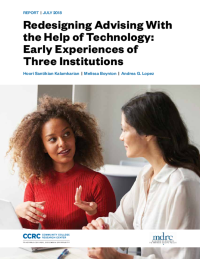Redesigning Advising With the Help of Technology
Early Experiences of Three Institutions

 A rapidly growing number of higher education institutions nationwide are implementing advising technologies — including education planning, counseling and coaching, and risk targeting technologies — to help students plan their academic paths and stay on track to graduation. Research suggests that these technologies may improve support for students if institutions also adopt advising structures and processes that leverage technology to provide a more intensive and personalized advising experience.
A rapidly growing number of higher education institutions nationwide are implementing advising technologies — including education planning, counseling and coaching, and risk targeting technologies — to help students plan their academic paths and stay on track to graduation. Research suggests that these technologies may improve support for students if institutions also adopt advising structures and processes that leverage technology to provide a more intensive and personalized advising experience.
This report from the Community College Research Center and MDRC describes how three institutions — the University of North Carolina, Charlotte (UNC Charlotte); California State University, Fresno (Fresno State); and Montgomery County Community College (MCCC) in Pennsylvania — are approaching comprehensive, technology-based advising reforms, presenting detailed examples of their new advising practices, outreach methods, and messages to students.
The advising redesigns at UNC Charlotte, Fresno State, and MCCC consisted of two key components: strategic outreach and advising sessions. All three institutions implemented strategies for making their outreach to students more sustained and strategic and for building student-advisor relationships through advising sessions that incorporate holistic discussions.
In their strategic outreach, each institution crafted plans for proactively communicating with students via email, phone, or text message at regular intervals throughout the semester — including at key decision points, such as the start of the semester and after faculty submit early-alert flags identifying students who may be struggling. Institutions’ outreach efforts included informational communication, or messages with standardized content on a particular topic, as well as targeted communication, which is typically personalized and addresses specific issues individual students have encountered, including their academic performance and needs. In developing their strategic outreach plans, all three institutions carefully considered the timing and frequency, mode of communication, and content and tone that would be most effective in their messages to students.
Institutions also designed advising structures intended to enable students to meet with advisors who would engage them in a data-informed discussion about their successes and challenges and how their progress aligns with their academic and career goals. Advisors would also assist students in navigating complex institutional structures and refer them to resources for additional help with both academic and nonacademic issues. To facilitate these sessions, each institution developed a “toolbox” for advisors outlining goals for student learning outcomes, topics for discussion, and guiding questions. All three institutions took a proactive approach to get students the support they needed when they needed it, requiring at least a subset of students to meet individually with an advisor once per semester.
Based on observations of the advising redesigns at UNC Charlotte, Fresno State, and MCCC, the report provides insights and ideas for other institutions seeking to redesign their advising practices around new technologies. Emerging themes include the following:
-
Structural changes are needed to transform how students experience advising. Advisors at broad-access institutions often have large caseloads and lack the capacity to engage students in holistic discussions during advising appointments. All three institutions in the current study took steps to restructure advising to improve advisors’ ability to have meaningful conversations with their students — for instance, by extending the length of advising time slots — and to encourage students to meet with their advisors.
-
Professional development is necessary to support advisors as they adopt holistic advising practices. Advisors at UNC Charlotte, Fresno State, and MCCC varied in their ability to create and sustain a meaningful teaching relationship with students — in part due to their limited access to evidence-based guidance on how to provide holistic advising. Advisors need additional resources and professional development opportunities that support their efforts to engage students on topics beyond course registration and short-term academic planning.
-
There are open questions about appropriate ways to use risk information and how to discuss risk data with students. All three sites utilize data — such as early-alert flags, midterm grades, and predictive analytics scores — to gauge students’ risk of falling off track in their programs and prompt targeted outreach. However, institutions and advisors struggled with how to discuss risk data with students in order to motivate them rather than discourage them, and questions emerged about the efficacy of some predictive analytics tools.
- Engaging multiple stakeholders in transformational advising redesigns is critical yet challenging. All three institutions included a range of stakeholders in their redesign efforts from the beginning, including those in advising, support services, information technology, and institutional research functions. However, the redesign process revealed that more advisors needed to be involved in both designing and implementing the intervention. Faculty involvement is also crucial for identifying signs that students are struggling.






